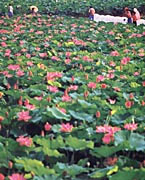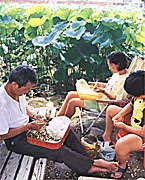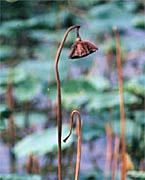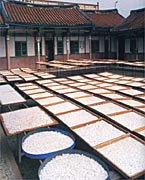 Spring breeze unveils the enchanting veils of swaying lotus greens
Spring breeze unveils the enchanting veils of swaying lotus greens
Spring thunder awakens the land. Drizzling rain nourishes the land. This is the season of lotus planting. "Li Chun'', the solar term marking the beginning of spring, rushes lotus farmers to begin a year of dedication to their crops. Still wearing a thin layer of chilliness, farmers begin the annual cycle of farming by nurturing the seedlings. They plow the land, fertilize it, disinfect it, irrigate it, and finally plant the hope for a year of good harvest.
Farmers grow lotus mainly from roots or seedlings, but seedlings from roots and stems are more prevalently used. The majority of farmers in Baihe develop their seedlings from two-sectioned lotus roots. On average, each hectare of lotus field requires 500 kg of lotus roots.
Around half a month later, green heads begin to peep out from the still surfaces of the shallow ponds. One after another, the buds pop open, waving their fresh green leaves to welcome the spring. A fanfare unfolds. The once quiet lotus fields become the playgrounds of youthful green spirits; some bow their heads timidly and others stretch their stems dancing in the rippled water along the enchanting rhythms of the breezes. The charming green fairies are warming up the lotus country for a colorful party. Lotus farmers join the party, weeding and fertilizing to usher in the flowering season. Around 20 days later, farmers fertilize for the second time and subsequently once every half a month, until the time to harvest the lotus seeds arrives. Different activities unfold in different seasons. Lotus farmers are busy throughout the year to bring us feasts for the body and soul.
 The summer sun seizes the mystique of lotus scents
The summer sun seizes the mystique of lotus scents
Sunlight sprinkles on the blushing petals of lotus flowers. Wide-open leaves dance in the cheering summer breeze. The lotus country is immersed in the fervent of pastel passion. After Ching-Ming, lotus fairies dressed in pastel colors rise from the layers of greens to compete in the summer pageant. The lotus country is drenched in an enchanting scent. Midsummer nights' cheering breezes lure the old and the young to the front courts of the old farmhouses. Chatters and laughter seized in the scented air condensed into poetic family moments. As the Song Dynasty poet, Cao Yin (曹寅), described, spots of pink dotted a pond of green leaves; scents of lotus filled homes with cheerful air.
Around two to three months after planting comes the harvest season for lotus seeds. The romantic green season and glamorous pink season lead us into the lotus seed season from June to September. Flower petals fall on the surface of the ponds paving way for the grand entrance of the delicious lotus seeds. Around 20 days after the flowers have fallen, the seeds are matured enough for harvest.
Defying the pricks on hard lotus stems, lotus farmers pick the seed cups under the scorching sun. The elderly, women and children work in relay to spoon out the shelled seeds (black seeds) and "mark" a cut on the shell. To "mark" this cut requires skills because the cut must go right through the shell without hurting the flesh, or the flesh turns dark and loses its market value.
After "marking" comes the step of "shelling," that is, removing the hard shell from the lotus seeds. The hard shell serves the purpose of protecting the seeds from injury. Once, a lotus seed of several thousand years was found. This seed was planted and miraculously sprouted into a new life. The shell is indeed a container of the miracle of life.
After shelling, white lotus seeds roll in the trays like shining pearls. But, the work does not stop here. The next step is to peel off the thin film. This is no easy task. It requires skilled hands to do a proper job. The process goes like this: take the pointed end in one hand and pinch the film with two fingers. Don't exert too much force; instead, rotate the lotus seed with the other hand. The film will rob off along the rotating motion. Long-grain lotus seeds are easier to peel than round-grain lotus seeds since the film is more fragile on round-grain seeds.
After removing the film, we come to the final step; that is, removing the extremely bitter core. The core is removed by inserting an awl through the center from the pointed end. The lotus seed core is extremely bitter, but it is an ancient herbal remedy to soothe inflammation. The farmers usually sun-dry the cores and keep them for use later or sell for a small side income, but the quantity is often too insignificant to be profitable.
For the breed of lotus planted as an economic crop, two to three thousand kilograms of lotus seeds are harvested from one hectare of land. Lotus seeds for Chinese medicine or drying are harvested when the shell hardens and turns black. Shelled lotus seeds are sunned for around a week before being packed and stored for use as an ingredient in Chinese medicine formulae.
 Autumn winds brush off the colors of fanfare
Autumn winds brush off the colors of fanfare
When summer slips off, the fanfare on lotus ponds quiets down. The scene of children peeling lotus seeds fades with the summer heat. Westerly winds sweep through the fields in late September. The mandarin ducks send the news of spring and lotus leaves signal the arrival of fall. Chilly winds sweep through the ponds, succumbing the lotus leaves into withering yellow. Protruding lotus seed cups stand against a few scattered flowers in the dried ponds, waving lonely in the entangling chills of fall. Broken lotus seed cups bow humbly to the reflections in the puddles, ceasing motions in the withering breathes of the season.
Some latecomers are still blooming in their best colors in September, making the final effort to dance in the autumn winds. However, without the complementing fanfare, autumn lotus wears a touch of loneliness under its elegant pink, because soon after, all colors in the pond will fade. Lotus flowers and leaves in October catch the last chance to showcase their beauty before the harsh winds sweep away the stage and the glamorous colors on them into the mud underneath, getting ready for the coming of a new life cycle.
 Winter winds unveil the treasure in the mud
Winter winds unveil the treasure in the mud
"Seeds in summer, roots in winter," this is the special lotus industry in Baihe. After the harvest of seeds, the lotus ponds sit still to dry. Underneath the brown mud mixed with withered flowers and leaves, lotus roots are stretching their fat legs in contentment.
Different from growers of the rice crops which are only harvested once in autumn, folks in lotus country are getting busy again deep into the winter. Farmers clad in thick winter clothes chase after a small excavator and pick the big fat legs of lotus roots. These are the materials for white lotus root flour.
Making lotus root flour is a time- and labor-consuming process. The lotus roots are hand-cut to remove the two ends before put to a good shower. Cleaned lotus roots are then sent to the crusher for final cleansing, crushing and grinding. The end result is lotus root pulp, which is stored in jars for the next step.
Now comes the complex part of traditional lotus root flour making. The women in the village strain the pulp with cheesecloth until the solution is pure white in high concentration. This often takes three days and three nights, soaking hands in freezing water. Every gram of the flour comes from hard work.
The high-concentration solution is then placed in a large porcelain bowl and covered with thick layers of cheesecloth and charcoal powder is placed on top. This is the traditional way to drain out the moisture and turn the mixture into hard powder cakes. The women then use a shaving knife or spoon to scrape the powder cakes into thin slices, which are then placed on bamboo screens and set outside to dry under the winter sun. The dried cakes turn into precious powder, which we use to make delicious desserts.
Lotus powder cooked with water into a thick soup is a remedy for stomach and intestine discomforts. It is also a popular recipe for beauty care and problems caused by inflammation. Approximately 0.1 hectares of land yields 120 kg of lotus root flour from the "shilian" variety and even less from the "Dahanlian" and "Silian" varieties. It is a precious product, not substitutable by cheap tapioca flour.